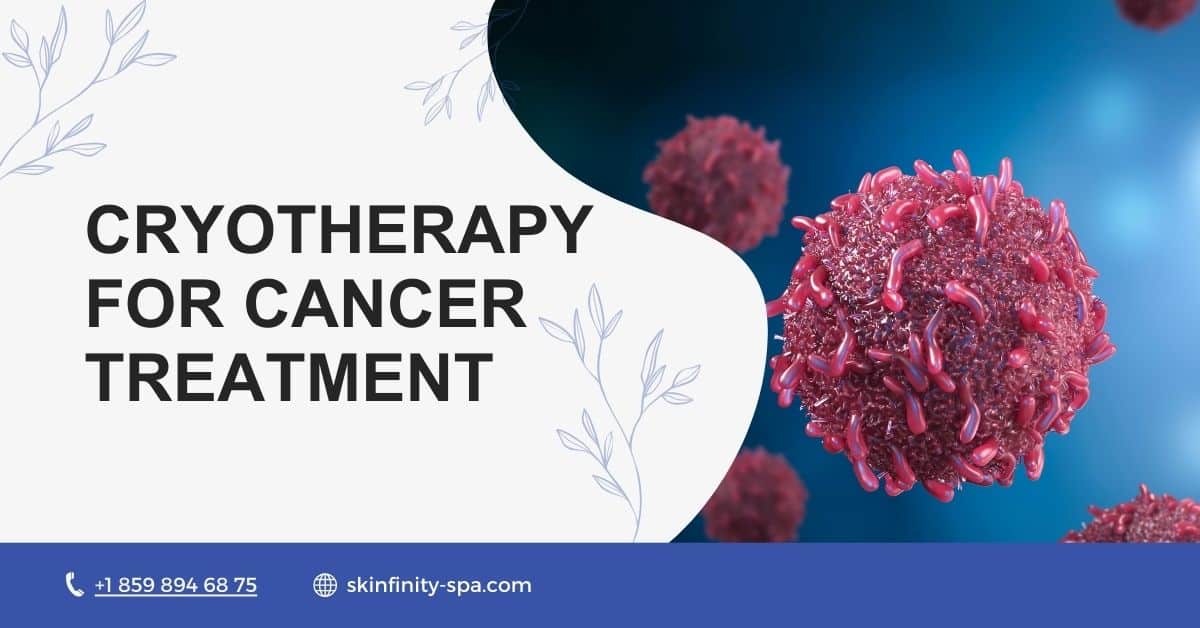Cryotherapy, an innovative approach in the realm of cancer treatment, employs extreme cold to target and destroy cancer cells. This method, often referred to as cryosurgery or cryoablation, utilizes liquid nitrogen or other cryogenic gasses to freeze abnormal tissue, effectively treating various types of cancer.
As research continues to expand our understanding, cryotherapy is emerging as a valuable option in coping with cancer.
What is Cryotherapy for Cancer Treatment?
Cryotherapy for cancer treatment is a minimally invasive procedure involving the application of extreme cold to treat tumors. During this process, a doctor uses a device called a cryoprobe, which directly delivers cold temperatures to the targeted tissue.
This freezing action may destroy cancer cells while minimizing damage to surrounding healthy tissue. The treatment can be performed percutaneously or with a small cut in the skin, making it a favorable option for patients seeking alternatives to traditional surgery.
Explore Our Range of Cryotherapy Facials
Specific Cancers Treated with Cryotherapy
1. Cryotherapy for Skin Cancer
Cryotherapy for skin cancer is a widely employed method that effectively targets and treats abnormal skin cells. By freezing the cancerous lesions, this treatment can eliminate superficial tumors while preserving healthy skin.
This localized approach is especially useful for basal cell carcinoma and squamous cell carcinoma, where timely intervention can reduce the risk of further complications.
Also Read: Does Cryotherapy Tighten Loose Skin?
2. Cryotherapy for Breast Cancer

Cryotherapy for breast cancer is gaining traction as a less invasive alternative to traditional surgical methods. This technique employs freezing temperatures to target and destroy tumor cells within the breast tissue.
As research continues to evolve, it may play a significant role in cases where patients wish to avoid extensive surgery or when tumors are detected at an early stage. The localized nature of cryotherapy allows for a focused attack on cancer cells while preserving surrounding healthy tissue.
3. Cryotherapy for Cervical Cancer
Cryotherapy for cervical cancer involves the freezing of abnormal cervical cells, effectively treating early-stage cancers. This minimally invasive procedure allows for the destruction of cancerous tissue while causing minimal discomfort to the patient.
It is particularly beneficial for women who may be apprehensive about more invasive surgical options. By freezing the affected area, cryotherapy may help in preventing the progression of cervical cancer while offering a favorable treatment experience.
Also Read : How cryotherapy cures Prostate Cancer
Explore Our Range of Cryotherapy Facials
4. Cryotherapy for Esophageal Cancer
Cryotherapy for esophageal cancer is an innovative method that targets tumors located inside the esophagus. Utilizing extreme cold, this treatment can effectively shrink or destroy cancer cells, providing relief from symptoms such as pain or difficulty swallowing.
As a less invasive option, it may also be used in conjunction with other cancer treatments, allowing patients to manage their condition more effectively.
5. Cryotherapy for Liver Cancer
Cryotherapy for liver cancer offers a targeted approach to treating tumors within the liver. By applying extreme cold, this treatment can destroy cancerous cells while preserving surrounding healthy tissue.
This method is particularly advantageous for patients who may not be candidates for traditional surgery.
As the field of cryotherapy expands, ongoing research aims to determine its efficacy and safety in liver cancer treatment, offering hope to those affected by this challenging disease.
6. Cryotherapy for Lung Cancer

Cryotherapy for lung cancer employs extreme cold to target and destroy tumors located within the lungs. This treatment, which may use liquid nitrogen to freeze abnormal lung tissue, is particularly beneficial for patients who are not candidates for traditional surgery.
By minimizing damage to surrounding healthy tissue, cryotherapy presents a localized approach that can be combined with other cancer treatments, enhancing overall efficacy and reducing potential side effects.
7. Cryotherapy for Oral Cancer
Cryotherapy for oral cancer is an emerging option that focuses on freezing cancerous lesions found in the mouth and throat. This treatment may effectively destroy abnormal cells while preserving healthy tissue, making it a favorable choice for patients.
The minimally invasive nature of cryotherapy allows for the management of symptoms such as pain and difficulty swallowing, improving the quality of life for those coping with oral cancer.
8. Cryotherapy for Ovarian Cancer
Cryotherapy for ovarian cancer is gaining attention as a method to treat tumors in the ovaries. This innovative treatment uses extreme cold to freeze and destroy cancer cells, potentially preventing the progression of the disease.
As research continues to explore its efficacy, cryotherapy may become an integral part of a comprehensive treatment plan for women facing ovarian cancer, offering a less invasive alternative to traditional surgical methods.
Explore Our Range of Cryotherapy Facials
9. Cryotherapy for Renal Cancer
Cryotherapy for renal cancer targets tumors located in the kidneys through the application of extreme cold. This treatment can effectively freeze and destroy cancer cells, making it a suitable option for patients with localized tumors.
By using a cryoprobe, doctors can minimize damage to surrounding healthy kidney tissue. Ongoing research aims to evaluate the long-term outcomes of cryotherapy for renal cancer, providing valuable insights into its role in cancer management.

Efficacy and Outcomes
Can Cryotherapy Cure Cancer?
While cryotherapy may not be a definitive cure for all types of cancer, it can significantly enhance treatment outcomes by destroying cancer cells and shrinking tumors.
This treatment is particularly effective for localized cancers, where it may be used in conjunction with other therapies.
How Cryotherapy Kills Cancer Cells?
Cryotherapy kills cancer cells by inducing cellular death through extreme cold temperatures. The freezing process disrupts the cell membrane, leading to the formation of ice crystals that effectively destroy cancerous tissue.
As the targeted areas thaw, the immune system is activated to remove the dead cells, further aiding in the elimination of tumor remnants. This dual action enhances the treatment’s effectiveness.
How Effective is Cryotherapy for Skin Cancer?
Cryotherapy has proven to be highly effective for treating skin cancer, especially for superficial tumors such as basal cell carcinoma and squamous cell carcinoma.
By freezing and destroying cancerous lesions, this method can significantly reduce the risk of recurrence.
Patients often report minimal side effects, making cryotherapy a preferred option for those seeking effective treatments for skin-related cancers.
Can Cryotherapy Make Cancerous Tumors Worse?
While cryotherapy is generally considered safe, there is a possibility that it may not be suitable for all patients.
In some cases, cryotherapy could potentially lead to incomplete tumor destruction or even stimulate tumor growth if not applied correctly.
Can Tumors Come Back After Cryotherapy?
Yes, tumors can come back after cryotherapy, especially if the initial treatment did not completely eliminate all cancerous cells.
Regular follow-ups are crucial for monitoring the treated area and identifying any recurrence.
Explore Our Range of Cryotherapy Facials
How Often is Cryotherapy Recommended for Cervical Cancer?
The frequency of cryotherapy treatments for cervical cancer varies based on individual patient needs and the extent of the disease.
Generally, cryotherapy may be recommended every few months, depending on the response to treatment and any existing abnormal cells.
Ongoing evaluation and adjustment of treatment plans are essential to ensure the best outcomes for patients undergoing cryotherapy for cervical cancer.
Safety and Risks
Find Out the Benefits and Risks of Cryotherapy in detail.
Can Cryotherapy Cause Cancer?
Generally, cryotherapy is regarded as a safe treatment that uses extreme cold to destroy cancer cells without causing additional harm.
However, there is ongoing research to fully understand the long-term effects of cryotherapy on cellular behavior.
Can Cryotherapy Cause Skin Cancer?
Concerns about cryotherapy potentially leading to skin cancer primarily stem from its application in treating abnormal skin cells. While this treatment effectively freezes and destroys cancerous lesions, it is essential to use cryotherapy judiciously to avoid damaging surrounding healthy tissue.
Current research indicates that when performed by skilled professionals, cryotherapy poses a low risk of causing skin cancer, making it a valuable tool in the fight against skin-related cancers.
Is Cryotherapy Safe for Cancer Patients?
Cryotherapy is generally considered safe for cancer patients, particularly for those looking for less invasive treatment options. It has been used to treat various types of cancer, including skin, cervical, and renal cancer, without significant side effects.
Does Cryotherapy for Prostate Cancer Harm Spinal Cord Stimulator?

Patients with a spinal cord stimulator may wonder if cryotherapy for prostate cancer poses risks to their device. The freezing process employed in cryotherapy primarily targets prostate tissue and is localized, minimizing effects on surrounding areas.
Learn More About : How To Use Cryotherapy for Prostate Cancer
Treatment Details and Process
What Type of Cancer is Treated with Cryotherapy?
Cryotherapy is employed in treating various types of cancer, with its effectiveness particularly noted in localized tumors. This treatment may be used for skin cancer, cervical cancer, liver cancer, and prostate cancer, among others.
The method involves freezing abnormal tissue with liquid nitrogen or a cryoprobe to destroy cancer cells while preserving nearby healthy tissue.
How Long Does Cryotherapy for Cancer Last?
The duration of cryotherapy for cancer can vary depending on the size and location of the tumor. Typically, the freezing process lasts from a few minutes up to an hour, followed by a thawing period.
After the treatment, patients might experience some temporary discomfort or swelling, but these side effects are usually manageable.
Explore Our Range of Cryotherapy Facials
How Often Should You Repeat Cryotherapy Pre-Cancer Treatments
The frequency of cryotherapy sessions prior to cancer treatments is determined by individual patient needs and the specific type of cancer being addressed.
Generally, cryotherapy may be recommended every few weeks or months, depending on the response to treatment and the extent of abnormal cells.
Post-Treatment and Recovery
How to Cure Stage IV Cancer by Cryotherapy?
Cryotherapy, while not a definitive cure for stage IV cancer, can be an integral part of a comprehensive treatment plan aimed at managing the disease more effectively.
This treatment that uses extreme cold targets specific tumors, potentially destroying cancer cells and shrinking tumor size. By employing techniques such as cryosurgery, doctors can directly freeze cancerous tissue, leading to localized damage while minimizing harm to surrounding healthy tissue.
As part of ongoing research, cryotherapy is being explored as a complementary approach alongside traditional cancer treatments to optimize patient outcomes in advanced stages.
What Happens to Cancer Cells After Cryotherapy?
After cryotherapy, the treated cancer cells undergo a process where extreme cold induces cellular death. The freezing temperatures disrupt membrane integrity, leading to the formation of ice crystals within the cells, which ultimately destroys them.
Following the thawing phase, the body’s immune system is activated to eliminate the dead cells, further aiding in the removal of any remaining tumor remnants.
Is Liquid Nitrogen Used in Cryotherapy for Dog Tumor?
Yes, liquid nitrogen is commonly used in cryotherapy for treating tumors in dogs, similar to its application in human medicine. This method utilizes extreme cold to freeze and destroy abnormal tissue effectively.
Must Read: How Cold Do Cryotherapy Chambers Get?
Veterinarians employ cryoprobes to deliver liquid nitrogen directly to the tumor site, ensuring precise treatment while minimizing damage to surrounding healthy tissue. This localized approach allows for effective management of various types of tumors in dogs, providing a less invasive alternative to traditional surgical options.
Cryotherapy for Precancerous Cells on Face
Cryotherapy is increasingly recognized as an effective treatment for precancerous cells on the face, particularly for conditions such as actinic keratosis. This treatment involves using extreme cold to freeze abnormal skin cells, effectively destroying them while minimizing damage to surrounding healthy tissue.
By applying cryotherapy, dermatologists can target precancerous lesions with precision, reducing the risk of progression to skin cancer. Research indicates that this method not only treats existing lesions but also promotes the regeneration of healthy skin, making it a valuable option for patients concerned about skin health.
Does Cryotherapy Help with Precancerous Cells?
Yes, cryotherapy has been shown to help with precancerous cells by effectively freezing and eliminating abnormal tissue. This treatment is particularly beneficial for precancerous conditions like actinic keratosis, where early intervention can significantly reduce the risk of developing skin cancer.
By employing localized cryotherapy techniques, dermatologists can target specific areas with minimal side effects, providing patients with a manageable and efficient treatment option.

